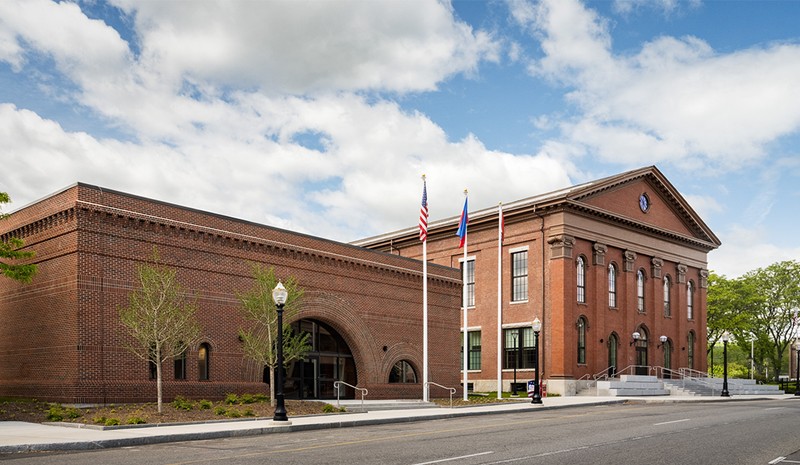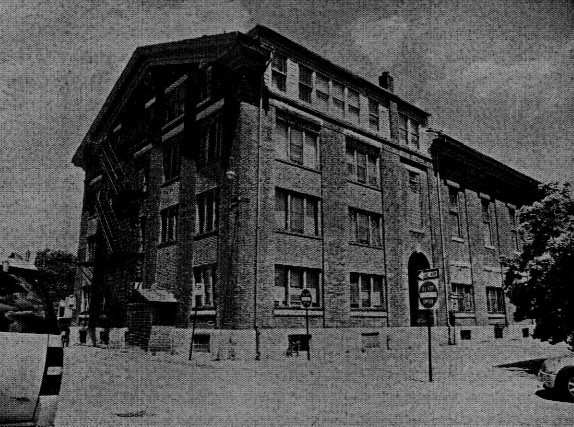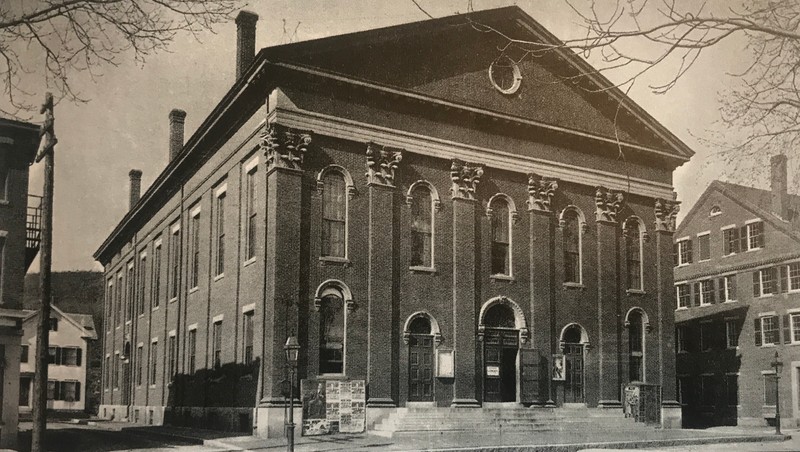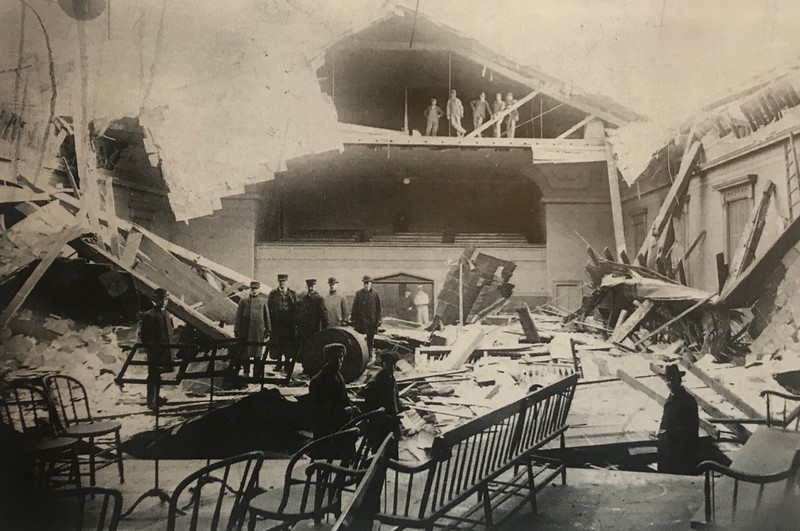The Fitchburg City Hall
Introduction
Text-to-speech Audio
Built in 1852, the Fitchburg city hall is an example of the continuous changes to the community. As the city has grown, the building containing the city government has grown with it. Many changes have taken place to accompany the expanding city, including new sections having to be built. It stands as a physical representation of the ever changing city’s history.
Images
The Finished City Hall Unveiled in 2021

1971 Rear of the City Hall, Designed by H.M. Francis

Historical Image of City Hall

This image by Joseph Moulton shows the 1904 roof collapse. According to the Fitchburg Historical Society: "The city determined that the damage was due to rusted truss rods. Controversy erupted over whether the city should repair the roof or build a new city hall. The city council decided to repair the roof and install new offices, which sacrificed the assembly hall."

Backstory and Context
Text-to-speech Audio
In 1852 the city of Fitchburg, then just a town, decided they had to replace the city hall, as the last one was not providing what they needed, as the population had doubled to 5,000 people over the past ten years. The committee assigned decided that it should be in the Upper Common, but due to the committee needing to make compromises, the building of the new city hall was delayed a few years and the current location of just south of the Upper Common was chosen. Col. Ivers Phillips, one of the members of the building committee, resigned to take up the construction of the original building in order to help make sure it could be completed at the proposed budget of $14,000.
Col. Ivers Philips decided on a Greek Revival style of architecture, drawing from the notorious democracies of history. He also used the local craftsman to help in the construction, creating a town hall from the labor of the town. Ward B Farrar was hired as a carpenter, Deacon SA Wheeler, as a stonemason, and Alonzo P Goodrich to be the brick-maker. While there is little of this original material in the modern building, the option to keep it in this Greek Revival style has persisted through the years, important to the integrity that the city was founded upon.
The Democratic State Convention was held at the then-unfinished town hall in September of 1852, demonstrating the growing importance of Fitchburg. A September 10 article in The Fitchburg Sentinel demonstrates this:
"It is but a few years since when a project of a railroad from Fitchburg to Boston was first started, that appeals for subsciptions and assitance were met by those to whom they were made by the contemptous inquiry of 'Where in the world is Fitchburg?' It is, therefore, somewhat signficant of its increased notoriety, at least, that the Democratic party of Massachusetts have not been afraid of bewildering their delegates by appointing the place of rendezvous at Fitchburg, or entertaining any fears of their losing themselves by the way." (quoted in Bailey).
The new Town Hall officially opened in January of 1853, and The Fitchburg Sentinel on January 7th described this event as "marking a new era in our town history... The building in every respect confers high credit, both upon the liberality of the citizens of the place, the judgment of the committee, and the skill of Col. Phillips, its contractor." (quoted in Bailey).
What started as offices on the first floor, and public space for meetings on the second floor, became outgrown by the surrounding city, so an extension had to be made. The city hall has expanded quite a lot from the original building, as the former Bank of America Building was donated and converted into a legislative building. H.M. Francis was a notable architect in the area in the 1870s, so in 1879, he was commissioned as the designer for an expansion on the building. This expansion became the four floors in the rear of the building and changed the interior layout of the building. It had the same face of the building, but it was completely changed. Then in 1864, to accommodate the new work and employees the state required, the previous meeting floor was turned into more office space. After this, a porch with stairs was added to the building. While the building has stayed the city hall for over 100 years, it is far different from what it started out as.
A 1904 speech, "Early History of the City Hall" given by Ebenezer Bailey at a meeting of the Fitchburg Historical Society, notes the historical importance of the building:
"For more than half a century it has been the center of the municipal and much of the social life of Fitchburg. Its walls have echoed to the voices of great and illustrious men. Wendell Phillips, Charles Sumner, Ralph Waldo Emerson, Oliver Wendell Holmes, Henry Ward Beecher, John G. Saxe, Anson Burlingame, and many others have stood upon its platform and moved and stirred the inhabitants of Fitchburg with words of wisdom, wit and eloquence. Here, during the War of the Rebellion, before the assembled and sorrowing people were held the public obsequies of some of our honored dead, whose bodies were brought back to us from southern battle-fields."
Henry David Thoreau additionally presented his lecture titled, "Walking, or The Wild," at City Hall on February 3, 1857. His speeches and others were sponsored by the Fitchburg Athenaeum. Membership peaked at about 150 and lectures cost fifteen cents for entry. Thoreau's speech was the last of the season speaking season, which did not continue the following year due to the 1857 depression.
In 2012 the main building was deemed unsafe due to a broken roof truss. The city government worked out of 166 Putnam Place for the time being. By 2016 they decided to revitalize the building, renovating the inside to be more modern and reconstructing the outside. Work had to be done as quickly as possible, as the city was working out of rental spaces after it was deemed unsafe. Completed in 2020, the building was deemed safe in 2021, and the city government could work out of it again.
The building has evolved with the city of Fitchburg, and it is only fair to say that it will likely continue to grow. The grand feeling the building evokes and the importance it holds to not only the city but the people who have aided in the changes. It stands as a pillar of how Fitchburg has grown through time, both in its physical modifications and the community's help in the development.
Sources
Bailey, Ebenezer. “Early History of the City Hall.” Proceedings of the Fitchburg Historical Society and Papers Relating to the History of the Town Read by Some of the Members., vol. IV, Fitchburg Historical Society, 1908, pp. 266–75.
“A Brief History of Fitchburg.” A Brief History of Fitchburg | Fitchburg, MA. Accessed April 10, 2022. http://www.ci.fitchburg.ma.us/443/Brief-History-of-Fitchburg.
“City Hall Campus.” Icon Architecture. Accessed April 10, 2022. https://www.iconarch.com/city-hall-campus#:~:text=The%20two%2Dstory%20Italianate%20Fitchburg,room%20on%20the%20second%20floor.
Clark, Cliff. “Renovation of Historic Fitchburg City Hall Is Finished.” Sentinel and Enterprise. Sentinel and Enterprise, December 9, 2020. https://www.sentinelandenterprise.com/2020/12/09/renovation-of-historic-fitchburg-city-hall-is-finished/.
Dean, Bradley P., and Ronald Wesley Hoag. “Thoreau’s Lectures after ‘Walden’: An Annotated Calendar.” Studies in the American Renaissance, 1996, pp. 241–362. JSTOR, http://www.jstor.org/stable/30227687.
“Fitchburg City Hall Campus.” BOND Building, October 21, 2021. https://bond-building.com/project/fitchburg-city-hall-campus/.
“Fitchburg City Hall,” July 27, 2011. Commonwealth of Massachusetts, Massachusetts Historical Commission.
“History of Fitchburg City Hall.” History of Fitchburg City Hall | Fitchburg, MA. Accessed April 10, 2022. http://www.ci.fitchburg.ma.us/446/History-of-Fitchburg-City-Hall.
Bell, Trent. Photograph. Fitchburg City Hall, 2021.
Kirkpatrick, Doris. The City and the River. Fitchburg, Massachusetts: Fitchburg Historical Society, 1971.
Historical Society, Fitchburg. Images of America: Fitchburg 2005
Historical Society, Fitchburg. Images of America: Fitchburg 2005
